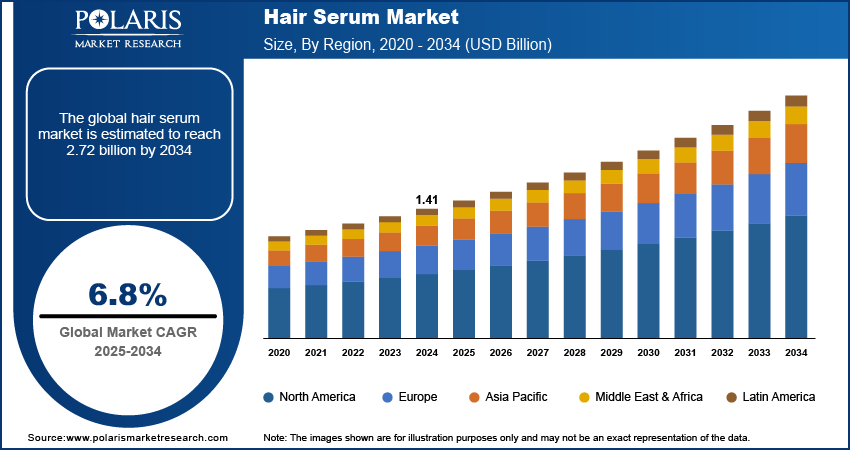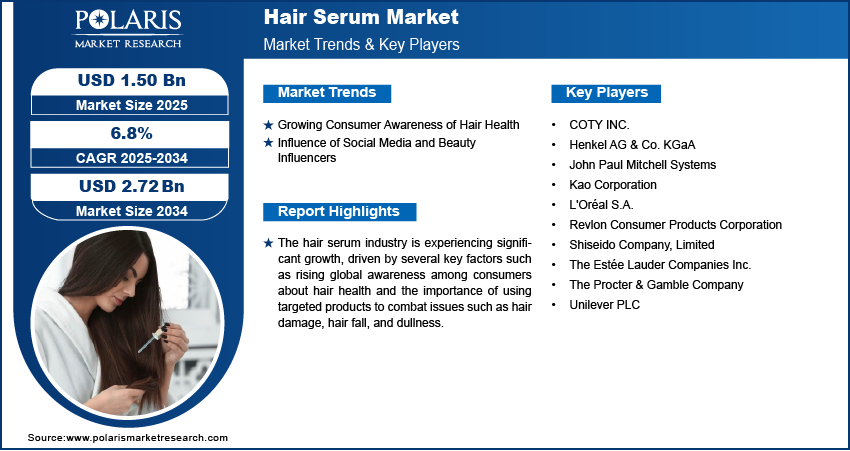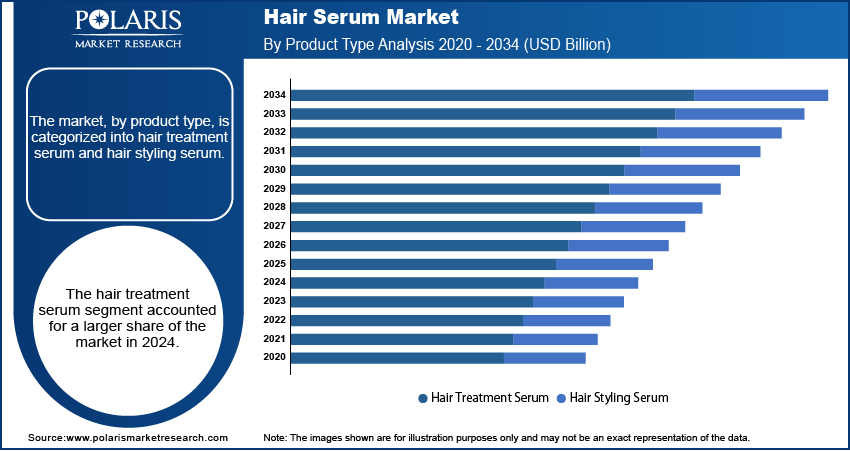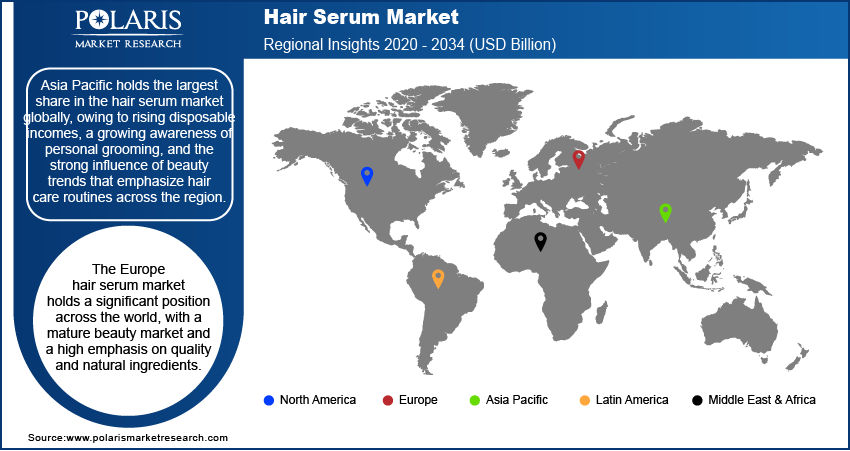
Hair Serum Market Size, Share, Trends, & Industry Analysis Report
By Product Type (Hair Treatment Serum and Hair Styling Serum), By Category, By Distribution Channel, By Region – Market Forecast, 2025–2034
- Published Date:Jun-2025
- Pages: 125
- Format: PDF
- Report ID: PM5814
- Base Year: 2024
- Historical Data: 2020-2023
Market Overview
The global hair serum market size was valued at USD 1.41 billion in 2024, and is anticipated to register a CAGR of 6.8% from 2025 to 2034. The increasing focus on personal grooming and hair health drives demand for hair serum. Consumers are also seeking solutions for common hair problems such as frizz and damage, which serums effectively address.
The hair serum market involves a variety of liquid-based products designed to address different hair concerns, such as frizz, damage, and dullness, while also providing shine and protection when used hair brush. These serums and eyelash serums are generally applied to the hair or eyelashes to enhance their appearance and health.

One major factor is the increasing awareness among consumers about hair health and the importance of personal grooming. Consumers are becoming more conscious of how pollution, heat styling, and chemical treatments can harm their hair, leading them to seek out protective and reparative solutions such as serums.
Another significant driver is the strong influence of social media and beauty influencers. These platforms and individuals play a huge role in shaping consumer preferences and educating people about new products and their benefits. For example, beauty influencers often share tutorials and reviews of hair serums on various platforms such as Facebook, Instagram, YouTube, and TikTok, showcasing the visible improvements these products can offer. This direct and engaging marketing content can quickly boost a product's popularity and drive demand. The Centers for Disease Control and Prevention (CDC) highlights that the rapid spread of information on social media can boost trends in the beauty sector and product visibility quickly.
Industry Dynamics
Growing Consumer Awareness of Hair Health
Consumers are increasingly aware of the impact of various factors, such as pollution, heat styling, and chemical treatments, on their hair health. Due to this awareness, they actively seek products that can protect and improve their hair's condition. Hair serums, with their targeted formulations for issues such as damage repair, frizz control, and shine enhancement, directly address these concerns.
A study published in StatPearls by Flores and others in 2024, titled "Anatomy, Hair," notes that approximately 100 hairs are shed daily, and disruptions in normal hair physiology can lead to pathological conditions such as alopecia. This highlights the ongoing need for protective and restorative hair care, which serums can provide. This growing emphasis on maintaining healthy hair drives demand for specialized products, including hair serums.
Influence of Social Media and Beauty Influencers
Social media platforms have become powerful channels for beauty trends and product discovery, with beauty influencers playing a significant role in shaping consumer preferences. These digital platforms offer a visual and interactive way for consumers to learn about new products, see real-time results, and get recommendations from trusted figures. The engaging content by influencers, such as tutorials and reviews, directly impacts purchasing decisions.
A review of makeup products, trends, and consumer behavior published in the International Journal of Research and Innovation in Social Science in February 2025 highlights that social media acts as a marketplace, inspiration hub, and educational resource for beauty enthusiasts. It also mentions that viral products and influencer endorsements drive demand for specific items. This widespread digital influence, showcasing the benefits and results of hair serums, significantly boosts their adoption and overall market growth.

Segmental Insights
By Product Type
The hair treatment serums segment held the largest share in 2024. The dominance is primarily attributed to the growing consumer concern for overall hair health, including issues such as hair fall, damage, and scalp health. These serums are formulated with active ingredients that aim to nourish, repair, and protect hair from various environmental stressors and styling damage. For example, individuals experiencing hair thinning might opt for a treatment serum with ingredients known to support hair density, aligning with studies on hair physiology and growth. The focus on long-term hair benefits and addressing specific hair problems makes hair treatment serums a dominant choice for many consumers.
The hair styling serum segment is anticipated to register the highest growth rate during the forecast period, driven by evolving beauty trends and the increasing desire for versatile hair looks. As consumers experiment more with different hairstyles, heat styling, and coloring, the need for products that can protect hair and enhance styling results becomes more critical. Hair styling serums offer benefits such as frizz control, shine, smoothness, and heat protection, which are essential for achieving desired looks without causing excessive damage. This segment's growth is also influenced by the rise of quick styling solutions and the desire for instant aesthetic improvements, as seen with the popularity of various styling techniques on social media.
By Category
The synthetic segment held a larger share of the market in 2024, mainly due to its widespread availability, often at more affordable prices, and immediate, noticeable effects. Synthetic ingredients, such as silicones, are highly effective in providing instant shine, smoothness, and frizz control, creating a protective layer on the hair. For example, a review on hair cosmetics published in PMC in 2015 highlights how ingredients such as silicones help to mimic the hair's natural lipid outer layer, seal the cuticle, and minimize frizz, providing significant cosmetic benefits. These characteristics appeal to a broad consumer base looking for quick and reliable results.
The natural/organic segment is anticipated to register a higher growth rate during the forecast period. This surge is driven by a growing global consumer preference for "clean beauty" products, fueled by increasing awareness of potential concerns associated with synthetic chemicals. Consumers are actively seeking products made with plant-based ingredients, essential oils, and botanical extracts, believing them to be gentler and more beneficial for long-term hair and scalp health. Research in The Good Boutique in 2023 points out that natural products are often packed with vitamins and minerals that promote healthy hair quality and reduce exposure to harsh chemicals. This rising demand for natural and sustainable options is significantly boosting the growth of this segment.
By Distribution Channel
The supermarkets and hypermarkets segment held the largest share in 2024. This dominance is attributed to their widespread accessibility, offering consumers the convenience of purchasing hair care products alongside their regular groceries. The ability to physically see and sometimes even sample products, combined with competitive pricing and a broad selection of well-known brands, makes these outlets a preferred choice for many. For instance, consumers often find familiar hair serum brands readily available during their weekly shopping trips, as highlighted by discussions on consumer purchasing habits for beauty products, where convenience and familiarity play a key role.
The online retail segment is anticipated to record the highest growth rate during the forecast period. This rapid expansion is driven by the increasing digital literacy of consumers, the ease of shopping from anywhere at any time, and access to a significantly wider product assortment not typically found in physical stores. Online platforms also provide abundant customer reviews and detailed product information, which helps consumers make informed decisions. The increasing penetration of e-commerce platforms and the popularity of online shopping for beauty products, as noted in various market insights, reflect this strong growth trend.

Regional Analysis
The Asia Pacific hair serum market held the largest share in 2024, driven by increasing disposable incomes, rapid urbanization, and a growing middle class with a rising interest in personal grooming. Consumers in countries across Asia Pacific are becoming more aware of hair damage caused by pollution and styling, leading to an increased demand for protective and restorative hair serums. The strong influence of K-beauty and J-beauty trends, which often emphasize elaborate hair care routines and innovative formulations, also contributes significantly to the region's market expansion. China, for example, is a key contributor to this growth, with its vast consumer base showing a rising preference for premium and effective hair care solutions.
North America Hair Serum Market Overview
The North America hair serum market is characterized by a high degree of consumer awareness regarding hair health and personal grooming. Consumers in this region are actively seeking sophisticated solutions for various hair concerns, including frizz, damage, and scalp issues. The market benefits from the presence of major international beauty brands and a strong demand for premium and multi-functional hair serums. The influence of beauty trends, often amplified by social media, also plays a significant role in driving product adoption across North America.
US Hair Serum Market Insight
In North America, the US represents a substantial portion of the market, driven by its large consumer base and strong spending power on personal care products. US consumers are particularly interested in innovative formulations, including those offering heat protection, shine enhancement, and anti-frizz benefits. There is also a rising trend toward natural and organic ingredients, as well as products that cater to specific hair types and concerns. The well-developed e-commerce infrastructure further supports the accessibility and growth of hair serum sales, which propels the US hair serum market expansion.
Europe Hair Serum Market
The Europe hair serum market holds a significant position across the world, with a mature beauty market and a high emphasis on quality and natural ingredients. European consumers are increasingly seeking hair care solutions that address problems such as hair loss, thinning, and environmental damage. The region also shows a strong preference for professional-grade products, often influenced by salon recommendations and expert advice. The overall focus on comprehensive hair health and personalized treatments contributes to the steady demand for hair serums across Europe. The Germany hair serum market plays a major role in Europe, due to its consumers' strong inclination toward high-quality and often organic hair care products. There is a growing awareness in Germany about the importance of ingredient transparency and sustainability, leading to a higher demand for natural and chemical-free formulations. German consumers are also interested in products that offer specific benefits, such as solutions for hair loss or scalp concerns, further fueling innovation and product variety in the local market.

Key Players and Competitive Insights
The hair serum market is highly competitive, featuring a mix of global and regional players vying for consumer attention. Companies constantly focus on innovation for new formulations and ingredients and adopt marketing strategies to differentiate their products and capture a larger share. This includes focusing on specific hair concerns, leveraging natural or organic trends, and expanding their reach through various distribution channels.
A few prominent companies in the industry include L'Oréal S.A.; The Procter & Gamble Company; Unilever PLC; Henkel AG & Co. KGaA; Kao Corporation; Shiseido Company, Limited; Revlon Consumer Products Corporation; John Paul Mitchell Systems; The Estée Lauder Companies Inc.; and COTY INC.
Key Players
- COTY INC.
- Henkel AG & Co. KGaA
- John Paul Mitchell Systems
- Kao Corporation
- L'Oréal S.A.
- Revlon Consumer Products Corporation
- Shiseido Company, Limited
- The Estée Lauder Companies Inc.
- The Procter & Gamble Company
- Unilever PLC
Hair Serum Industry Developments
June 2025: Drybar introduced the Overnight Hair Serum as part of their new brand, Messy by Alli Webb. This leave-in treatment is made with natural oils such as castor, acai, and argan, plus a sunflower blend. It works while you sleep to nourish, strengthen, and smooth hair, aiming to fix breakage and frizz so hair looks softer and stronger by morning.
March 2025: Olaplex launched their No.0.5 Hydrating & Strengthening Scalp Serum. This light gel serum contains ceramides, hyaluronic acid, and rice bran oil, along with Olaplex's special bond-building technology.
Hair Serum Market Segmentation
By Product Type Outlook (Revenue – USD Billion, 2020–2034)
- Hair Treatment Serum
- Hair Fall Control
- Hair Growth
- Dandruff Control
- Scalp Repair
- Others
- Hair Styling Serum
- Frizz Control
- Smoothing and Straightening
- Heat Protection
- Others
By Category Outlook (Revenue – USD Billion, 2020–2034)
- Natural/Organic
- Synthetic
By Distribution Channel Outlook (Revenue – USD Billion, 2020–2034)
- Supermarkets & Hypermarkets
- Pharmacy & Drug Store
- Online Retail
- Others
By Regional Outlook (Revenue – USD Billion, 2020–2034)
- North America
- US
- Canada
- Europe
- Germany
- France
- UK
- Italy
- Spain
- Netherlands
- Russia
- Rest of Europe
- Asia Pacific
- China
- Japan
- India
- Malaysia
- Suth Korea
- Indnesia
- Australia
- Vietnam
- Rest of Asia Pacific
- Middle East & Africa
- Saudi Arabia
- UAE
- Israel
- Suth Africa
- Rest of Middle East & Africa
- Latin America
- Mexic
- Brazil
- Argentina
- Rest of Latin America
Hair Serum Market Report Scope
|
Report Attributes |
Details |
|
Market Size in 2024 |
USD 1.41 billion |
|
Market Size in 2025 |
USD 1.50 billion |
|
Revenue Forecast by 2034 |
USD 2.72 billion |
|
CAGR |
6.8% from 2025 to 2034 |
|
Base Year |
2024 |
|
Historical Data |
2020–2023 |
|
Forecast Period |
2025–2034 |
|
Quantitative Units |
Revenue in USD billion and CAGR from 2025 to 2034 |
|
Report Coverage |
Revenue Forecast, Competitive Landscape, Growth Factors, and Industry Insights |
|
Segments Covered |
|
|
Regional Scope |
|
|
Competitive Landscape |
|
|
Report Format |
|
|
Customization |
Customize report according to your countries, regions, and segmentation requirements. |
FAQ's
The global market size was valued at USD 1.41 billion in 2024 and is projected to grow to USD 2.72 billion by 2034.
The global market is projected to register a CAGR of 6.8% during the forecast period.
Asia Pacific dominated the market share in 2024.
A few key players in the market include L'Oréal S.A.; The Procter & Gamble Company; Unilever PLC; Henkel AG & Co. KGaA; Kao Corporation; Shiseido Company, Limited; Revlon Consumer Products Corporation; John Paul Mitchell Systems; The Estée Lauder Companies Inc.; and COTY INC.
The hair treatment serum segment accounted for a larger share of the market in 2024.
The hair styling serum segment is expected to witness a faster growth during the forecast period.
